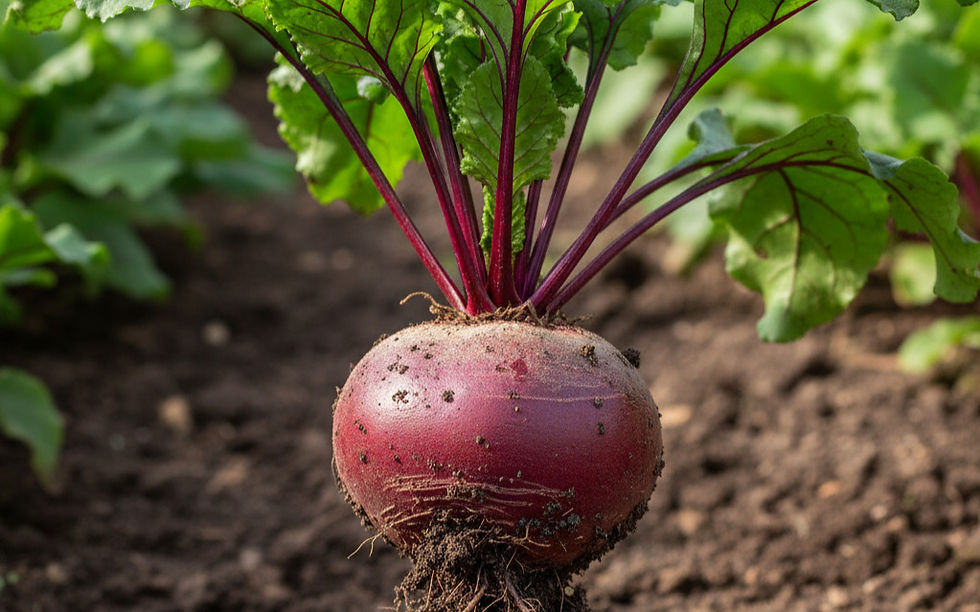Beta vulgaris(Amaranthaceae) - BeetRoot
- Das K

- 6 days ago
- 4 min read
(Beetroot)

1. Taxonomic insights
Species: Beta vulgaris
Family: Amaranthaceae
Genus: Beta
Related Herbs from the same family:
Amaranthus spinosus (Prickly Amaranth, Tanduliya) - A common leafy vegetable (shaak) across India, used in Ayurveda for its diuretic, cooling, and blood-purifying properties.
Amaranthus viridis (Slender Amaranth, Chauli) - Another widely consumed green, valued for its nutritive and digestive benefits.
Spinacia oleracea (Spinach, Palakya) - A well-known nutritive vegetable from the same family, though of Persian origin, now cultivated pan-India.
Chenopodium album (Bathua, Vastukah) - A wild edible green extensively used in North Indian cuisine and traditional medicine for its cooling and anthelmintic properties.
2. Common Names:Scientific Name: Beta vulgaris | English: Beetroot, Garden Beet, Red Beet | Sanskrit: Palanki, Yastyahva | Hindi: Chukandar | Tamil: Beetroot Kilangu, Cīkar kiḷaṅku | Telugu: Beetroot | Kannada: Beetroot | Malayalam: Beetroot | Marathi: Bit | Bengali: Beet | Nepali: | Urdu: Chukandar | French: Betterave | Spanish: Remolacha | Italian: Barbabietola | German: Rote Bete | Chinese: 甜菜 | Russian: Свёкла | Japanese: ビート | Africaans: |
3. Medicinal Uses:Antioxidant, Anti-inflammatory, Hepatoprotective (liver-protecting), Hypotensive (blood pressure-lowering), Demulcent, Laxative, Diuretic, Nutritive Tonic, Cardioprotective, Aphrodisiac (in traditional texts).
4. Phytochemicals specific to the plant and their action.
Betalains: Betanin (the red pigment) and Vulgaxanthin (the yellow pigment). These are the primary pigments, acting as potent Antioxidants and Anti-inflammatory agents. They help protect cells from oxidative damage and reduce inflammation.
Nitrates (Dietary): Inorganic nitrates. These compounds are converted in the body to nitric oxide, which causes vasodilation (widening of blood vessels), leading to its Hypotensive and potential ergogenic (performance-enhancing) effects.
Flavonoids and Phenolic Acids: Rutin, Epicatechin, Caffeic Acid. These compounds contribute significantly to the plant's overall Antioxidant capacity and support vascular health.
Saponins: These compounds have been studied for their potential Anti-inflammatory and Cholesterol-lowering effects.
Minerals: High in Potassium, Iron, and Folate. These support its role as a Nutritive Tonic, aiding in anemia management, electrolyte balance, and overall cellular function.
5. Traditional and Ethnobotanical uses covering the Medicinal uses.
Raktapitta & Pandu (For Blood Purification and Anemia)
Formulation: Fresh beetroot juice or cooked beetroot.
Preparation & Use: Consuming 50-100 ml of fresh beetroot juice daily or including cooked beetroot in the diet is a common practice.
Reasoning: Its high iron and folate content supports red blood cell production, addressing anemia. Its blood-purifying (Raktashodhaka) property is attributed to its antioxidant and hepatoprotective actions, helping the liver cleanse the blood.
Yakrit Vikar (For Liver Health)
Formulation: Beetroot juice with lemon.
Preparation & Use: A glass of beetroot juice with a squeeze of lemon is consumed to support liver function and detoxification.
Reasoning: The betalains and other antioxidants protect liver cells from toxic damage and support the liver's natural detoxification pathways, demonstrating Hepatoprotective effects.
Raktachapa (For High Blood Pressure)
Formulation: Raw beetroot juice.
Preparation & Use: 50-100 ml of raw beetroot juice is consumed daily to help manage hypertension.
Reasoning: The dietary nitrates in beetroot are converted to nitric oxide, which relaxes and dilates blood vessels, improving blood flow and lowering blood pressure (Hypotensive).
Vibandha (For Constipation)
Formulation: Cooked beetroot or beetroot salad.
Preparation & Use: Eating boiled or roasted beetroot as part of a meal provides dietary fiber.
Reasoning: The significant dietary fiber content adds bulk to the stool and promotes healthy bowel movements, acting as a mild Laxative.
Vajikarana (As an Aphrodisiac)
Formulation: Beetroot halwa or juice with milk.
Preparation & Use: Beetroot is cooked with milk, ghee, and sugar to make a sweet preparation (halwa).
Reasoning: Traditionally, it is considered a strengthening tonic (Balya) that can enhance vitality and performance. This is likely linked to its ability to improve blood circulation via nitric oxide.
6. Culinary uses- Decoction, teas, juices and Healing recipes.
Rasayana Juice for Blood and Liver Health
Purpose: A nutritive and detoxifying tonic.
Preparation & Use:
Take one medium-sized raw beetroot, one carrot, and a small piece of ginger.
Blend them together with a cup of water.
Strain and drink once daily, preferably in the morning.
Beetroot Halwa for Strength and Vitality
Purpose: A nourishing and energy-building sweet dish.
Preparation & Use:
Grate a cup of fresh beetroot.
Sauté it in ghee, then add milk and cook on low heat until the milk is absorbed and the beetroot is soft.
Add sugar or jaggery and cardamom powder. Garnish with nuts. This is a traditional preparation for convalescents and to build strength.
Simple Roasted Beetroot for Digestion
Purpose: A fiber-rich side dish.
Preparation & Use:
Cut beetroots into cubes, toss with olive oil, salt, and herbs.
Roast in an oven until tender. This simple method preserves nutrients and provides a healthy dose of fiber.
7. Disclaimer:Beetroot is safe for most people when consumed in food amounts. Excessive intake can lead to a temporary, harmless condition called beeturia (red-colored urine/stool). Due to its high oxalate content, individuals prone to oxalate-based kidney stones should consume it in moderation. The high nitrate content warrants caution for individuals with very low blood pressure or on specific medications. Consult a healthcare provider before using it therapeutically for any condition, especially during pregnancy.
-x-x-
8. Reference Books, Books for In-depth Study:Indian Materia Medica by Dr. K.M. NadkarniThe Ayurvedic Pharmacopoeia of India
9. Further study:Amaranthus (Amaranthus spp.) - Family Amaranthaceae. Similar to beetroot, amaranth leaves are incredibly rich in iron, calcium, and antioxidants, making them a potent remedy for anemia and used as a blood purifier in traditional systems.
Carrot (Daucus carota) - Family Apiaceae. Like beetroot, carrots are a rich source of beta-carotene (a powerful antioxidant), are highly nutritive, and their juice is often combined with beetroot juice for a synergistic blood-building and detoxifying effect.



Comments